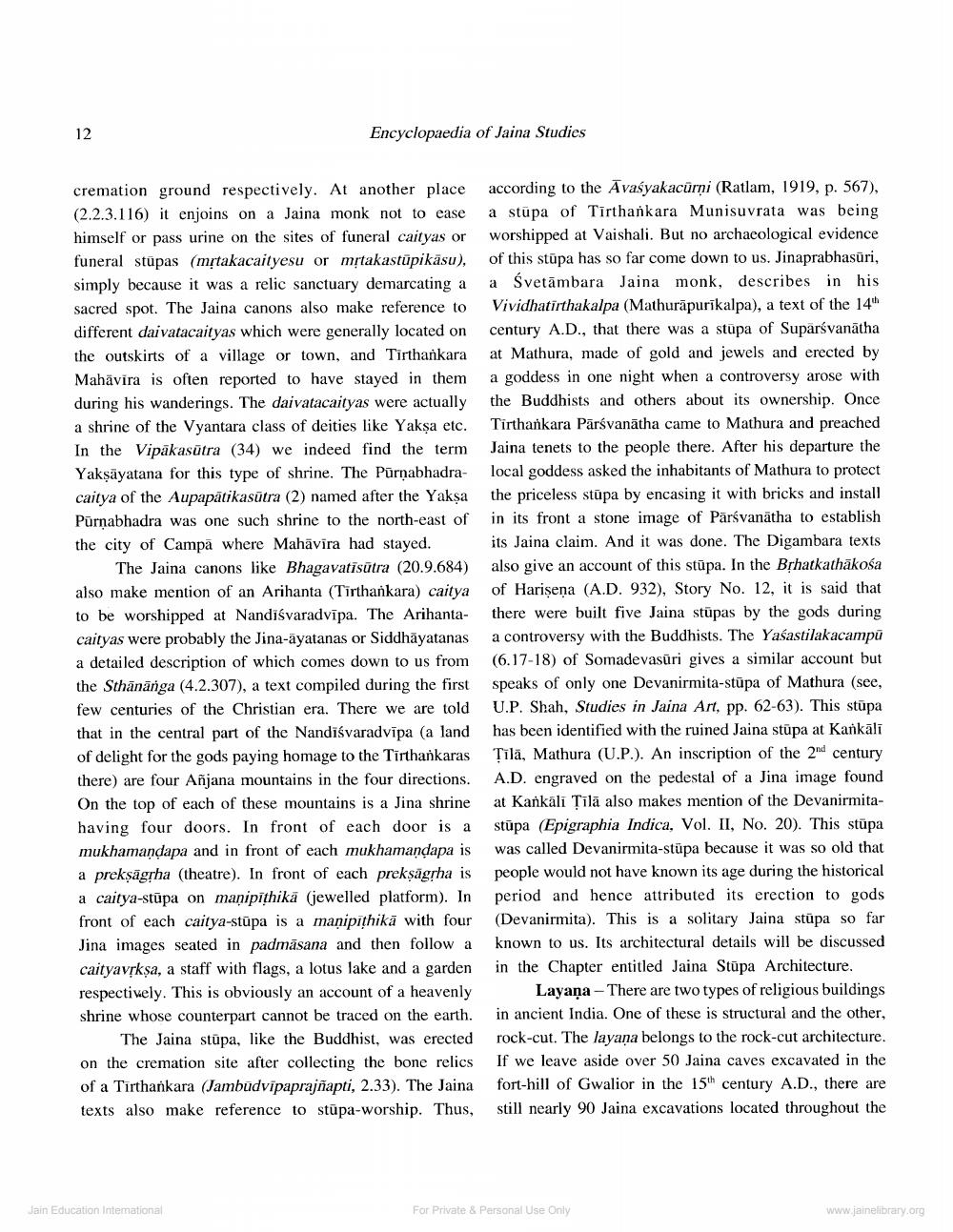________________
12
Encyclopaedia of Jaina Studies
cremation ground respectively. At another place (2.2.3.116) it enjoins on a Jaina monk not to ease himself or pass urine on the sites of funeral caityas or funeral stūpas (mrtakacaityesu or mstakastupikäsu), simply because it was a relic sanctuary demarcating a sacred spot. The Jaina canons also make reference to different daivatacaityas which were generally located on the outskirts of a village or town, and Tirthankara Mahavira is often reported to have stayed in them during his wanderings. The daivatacaityas were actually a shrine of the Vyantara class of deities like Yakşa etc. In the Vipākasutra (34) we indeed find the term Yakşayatana for this type of shrine. The Purnabhadra- caitya of the Aupapātikasutra (2) named after the Yaksa Pūrņabhadra was one such shrine to the north-east of the city of Campā where Mahāvīra had stayed
The Jaina canons like Bhagavatīsūtra (20.9.684) also make mention of an Arihanta (Tīrthankara) caitya to be worshipped at Nandiśvaradvīpa. The Arihanta- caityas were probably the Jina-ayatanas or Siddhayatanas a detailed description of which comes down to us from the Sthānanga (4.2.307), a text compiled during the first few centuries of the Christian era. There we are told that in the central part of the Nandiśvaradvipa (a land of delight for the gods paying homage to the Tirthankaras there are four Añjana mountains in the four directions. On the top of each of these mountains is a Jina shrine having four doors. In front of each door is a mukhamandapa and in front of each mukhamandapa is a preksāgrha (theatre). In front of each preksāgrha is a caitya-stūpa on manipithikā (jewelled platform). In front of each caitya-stupa is a manipīthikā with four Jina images seated in padmāsana and then follow a caityavskșa, a staff with flags, a lotus lake and a garden respectively. This is obviously an account of a heavenly shrine whose counterpart cannot be traced on the earth.
The Jaina stūpa, like the Buddhist, was erected on the cremation site after collecting the bone relics of a Tirthankara (Jambudvipaprajñapti, 2.33). The Jaina texts also make reference to stūpa-worship. Thus,
according to the Avasyakacūrni (Ratlam, 1919, p. 567), a stupa of Tirthankara Munisuvrata was being worshipped at Vaishali. But no archaeological evidence of this stūpa has so far come down to us. Jinaprabhasūri, a Svetāmbara Jaina monk, describes in his Vividhatirthakalpa (Mathurāpurikalpa), a text of the 14" century A.D., that there was a stupa of Supārsvanātha at Mathura, made of gold and jewels and erected by a goddess in one night when a controversy arose with the Buddhists and others about its ownership. Once Tirthankara Pārsvanātha came to Mathura and preached Jaina tenets to the people there. After his departure the local goddess asked the inhabitants of Mathura to protect the priceless stūpa by encasing it with bricks and install in its front a stone image of Pārsvanātha to establish its Jaina claim. And it was done. The Digambara texts also give an account of this stūpa. In the Brhatkathākosa of Harişeņa (A.D. 932), Story No. 12, it is said that there were built five Jaina stupas by the gods during a controversy with the Buddhists. The Yaśastilakacampū (6.17-18) of Somadevasūri gives a similar account but speaks of only one Devanirmita-stūpa of Mathura (see, U.P. Shah, Studies in Jaina Art, pp. 62-63). This stūpa has been identified with the ruined Jaina stūpa at Kankāli Tīlā, Mathura (U.P.). An inscription of the 2nd century A.D. engraved on the pedestal of a Jina image found at Kankäli Țilā also makes mention of the Devanirmitastūpa (Epigraphia Indica, Vol. II, No. 20). This stupa was called Devanirmita-stupa because it was so old that people would not have known its age during the historical period and hence attributed its erection to gods (Devanirmita). This is a solitary Jaina stūpa so far known to us. Its architectural details will be discussed in the Chapter entitled Jaina Stupa Architecture.
Layaņa - There are two types of religious buildings in ancient India. One of these is structural and the other, rock-cut. The layaņa belongs to the rock-cut architecture. If we leave aside over 50 Jaina caves excavated in the fort-hill of Gwalior in the 15th century A.D., there are still nearly 90 Jaina excavations located throughout the
Jain Education Intemational
For Private & Personal Use Only
For Private & Personal Use Only
www.jainelibrary.org




